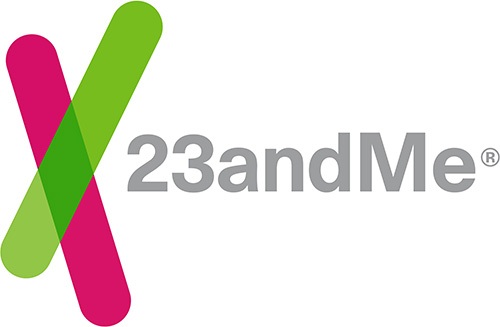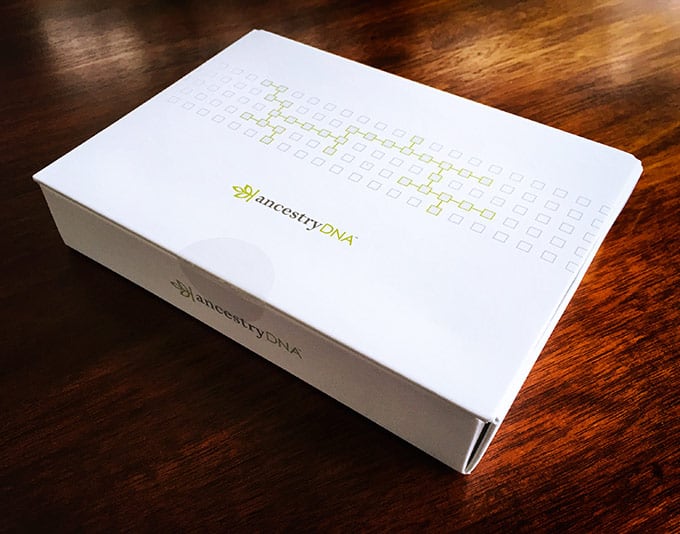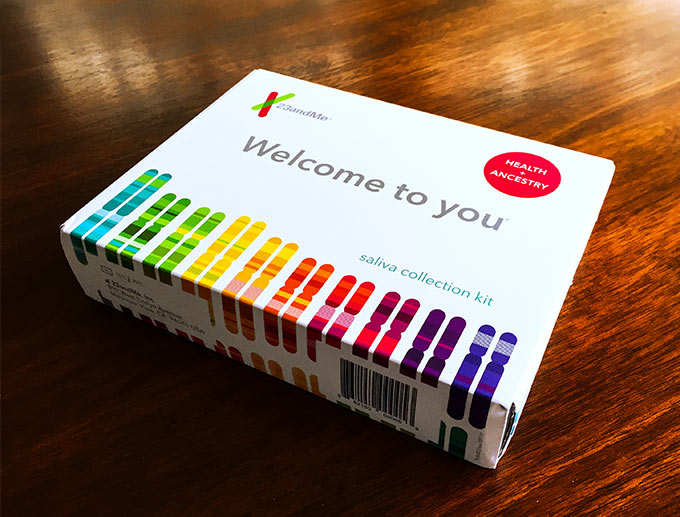In this article, we’ll compare two industry leaders head-to-head, 23andMe vs AncestryDNA, to help you decide which one is best for you.
 |
 |
|---|---|
| Best for...(our verdict) | |
|
|
| Price | |
| See latest price |
See latest price |
| Ethnicity estimates and regions | |
| Yes (1,500+ regions) | Yes (2,000+ regions) |
| Tests offered | |
|
|
| Family matching and database size | |
| Yes (20 million) | Yes (12 million) |
| Health screening | |
| Yes | Yes |
| Where to buy | |
| Ancestry.com | 23andMe.com |
Prices tend to fluctuate so be sure to check the latest pricing in the links above.
Both DNA tests are autosomal tests and report your ethnicity, provide family matches, and offer health reports. 23andMe also does basic yDNA (for males) and mtDNA testing to identify haplogroups (does not include yDNA or mtDNA matching).
Here are some of the most important differences between 23andMe and Ancestry:
The bottom line
AncestryDNA is an autosomal DNA test (the DNA passed down by all your ancestors – both maternal and paternal lines) and has a much larger customer database (20 million) than 23andMe (12 million) making it the better choice if you’re testing for genealogy.
23andMe is also an autosomal test but also tests Y-DNA (males only), and mitochondrial DNA. While AncestryDNA also offers health testing, 23andMe has more advanced health testing which is approved by the FDA.
Video comparison
AncestryDNA
AncestryDNA is by far the most popular consumer DNA test. It has a massive database of 20 million customers who are potential DNA matches. This makes AncestryDNA incredibly useful for genealogical research purposes.

Click here to see latest pricing and promos or read our full AncestryDNA review.
What we like:
- Database of over 20 million customers for matching
- Very strong genealogical community
- Can connect with matches through anonymous email and message boards
- Can link your DNA results to your online family tree
What we don’t like
- No longer offers separate mtDNA or Y-DNA tests
- Requires an ongoing subscription to view family trees of your matches
- Does not allow raw data uploads from other sites
23andMe

Click here to see latest pricing and promos or read our full 23andMe review.
What we like:
- Only site to offer health and wellness reports
- Has a large database of more than 12 million customers
- Includes a chromosome browser for comparing results
What we don’t like
- Very limited genealogical community compared to other sites
- No Y-DNA or mtDNA matching
- Does not allow upload of raw data from other sites
In this guide:
- Ethnicity Estimates
- Tests Offered
- Family/Cousin Matching
- Raw Data Download
- Health Screening
- Price
- Our Final Verdict
Now let’s take an in-depth look at each of those features, so you know exactly what we’re talking about, and can pick the best company for your needs (you can also check out our complete guide to the best DNA test kit).
Ethnicity estimates
When you buy a DNA kit, the main results you’ll receive from both AncestryDNA and 23andMe is an ethnicity estimate.
This is a breakdown of what regions of the world your ancestors came from based on how your DNA sample compares to millions of other DNA samples referred to as reference populations.
Each company’s ancestry test breaks the world down into regions based on the DNA patterns that have historically been found there.
For example, the DNA typically found in Ireland is different from that found in Scandinavia or the Middle East.
By seeing how closely your DNA matches specific genetic markers from these areas, the testing DNA companies can give you a guess as to how much of your DNA comes from each region.
At the moment, AncestryDNA breaks the world down into 1,500+ regions, while 23andMe uses 2,000+ regions.
It is important to keep in mind that these are only estimates, and the more specific you go, the lower the statistical confidence becomes.
So more regions isn’t always better.
These estimates are based on the most up to date research and algorithms, but everyday researchers want to learn more.
As more people get tested, the tests improve their accuracy.
Several years ago, for example, AncestryDNA’s test tended to overestimate a person’s Scandinavian heritage, a problem that they have since fixed.
AncestryDNA has a much larger customer database (20 million customers) from other people who have been tested, which means their results might be a little more accurate, but probably not enough to make a difference.
Ethnicity Winner: It’s a tie
Tests offered
AncestryDNA only has one test available, which is an autosomal DNA test.
This is the DNA passed down to you by all of your ancestors – both maternal and paternal lines. It gets mixed together with each generation, so it can’t tell you much about your family farther back than about six to eight generations.
However, since that’s the limit that most genealogists can find a paper trail, that may be all you need for now.
23andMe offers an ancestry test bundle that not only includes an autosomal test, but mitochondrial DNA (mtDNA) and Y-chromosome DNA (YDNA) as well.
YDNA and mtDNA let you trace a single family line very far back into the past – hundreds and even thousands of years.
For YDNA, this is your direct paternal line; for mtDNA, it’s your direct maternal line.
By testing your mtDNA and YDNA, 23andMe can give you information about your haplogroups.
Your haplogroups can help you trace your family’s locations and migration patterns far back into the past.
Unfortunately, the bundled test offered by 23andMe uses only very basic mtDNA and YDNA testing.
It will give you basic information, but there are better choices if that is your goal.
FamilyTreeDNA, for example, has mtDNA and YDNA tests that are much more thorough and therefore will provide you with more accurate and more useful results.
But they will cost you more, too.
23andMe also gives you the option of including health reports with your genealogical testing. See the Health Screening section below for more details.
Tests Offered Winner: 23andMe
Family/cousin matching
Probably the single biggest benefit of having genealogical DNA testing done is to connect with your living relatives.
Chances are you know your aunts, uncles, and first cousins, but a lot of us have never met our second cousins and may have no clue how many third or fourth cousins we have out there or who they are.
Testing your DNA can tell you exactly that.
Both 23andMe and AncestryDNA provide you with ways to connect with your cousins and other living relatives.
Naturally, they can only connect you to other people who have been tested, so you won’t find all of them, but you’ve got an excellent chance to find a bunch.
For both companies, letting relatives find and connect with you is optional.
You have to agree to share your results before anyone can find you, or before you can find anyone else.
This may sound a bit scary, but keep in mind two things.
First, neither of these two companies give your info out to everyone, only to people who are a close genetic match.
Second, the only information you’re actually sharing is your contact information, specifically your email address.
Other folks don’t see anything but how to contact you, and how you are related.
While both companies offer this service, AncestryDNA is much better when it comes to connecting with family members.
Ancestry is all about genealogy, and the people who use it want to know more about their relatives and ancestors.
Anyone who gets tested through AncestryDNA is likely to want to share their results and will welcome hearing from you.
On the other hand, many of the people who get tested through 23andMe are doing it because of the medical screening more so than the genealogical aspects.
That means they are much less likely to be interested in sharing their info or even replying to messages.
AncestryDNA has tested a lot more people so far, too, 20 million compared to 12 million through 23andMe.
Naturally, the more people who have been tested, the more likely you are to find a match.
That means you can expect to find more relatives through AncestryDNA than through 23andMe.
Ancestry also lets you connect your DNA to your online family tree, and helps you search possible matches from millions of other trees.
23andMe doesn’t have online family trees, which can make it tougher to work out exactly how you might be related to your genetic matches.
Family/Cousin Matching Winner: AncestryDNA
Raw data download
The results you see on both websites are summaries of your test and how your results compare to other people.
Most of the time that means you aren’t looking at the actual results.
That’s actually a good thing because your full results is a table that contains over 700,000 pieces of information.
Even though your raw genetic data isn’t likely to make any sense to you at all, both companies give you the option of downloading it.
Why?
Because then you can upload it to other sites if you want.
As we mentioned above, if you test through 23andMe, your options for connecting your results to genealogical research may be limited.
But downloading the data from your DNA test can help you get around that.
You can then take that raw data to another website that offers the genealogy tools that 23andMe doesn’t.
FamilyTreeDNA and MyHeritage, for example, let you upload your raw DNA data from other sites.
That means you can use all of the incredible tools that other companies offer, in addition to your results and tools from 23andMe or AncestryDNA.
Another useful site is GEDmatch, a free site that has powerful tools to link your DNA results to your family tree.
The site uses raw DNA that customers export from every major testing company on the market today.
Both Ancestry and 23andMe allow you to download your raw DNA.
It’s important to note that only your autosomal DNA raw data can be transferred to other sites. For more on this, see how to transfer DNA to other sites.
The YDNA and mtDNA results from 23andMe can’t be transferred, since other sites either don’t use them or test them differently.
Raw Data Download Winner: It’s a tie
Health screening
23andMe has one unique feature that no other genealogical DNA testing company offers.
It gives you the option of getting a health test done based on your DNA. The health screening costs more, but it could be worth it.
When you get a health screening done through 23andMe, you will receive a set of four reports: carrier status reports, trait reports, wellness reports, and genetic health risk reports.
Keep in mind that your genes influence your health, but in most cases, they don’t guarantee it.
You can use 23andMe health screening as a starting point to find out more about your health risks, but you should never rely on them for health advice or guidance.
Always be sure to consult a qualified healthcare provider before making any health-related decisions.
Carrier status reports
Every person carries two types of genes, dominant and recessive.
Our dominant genes are more obvious because they are the ones that affect our appearance and health.
Recessive genes are genes that are not active in you, but which can be passed down to your children.
The health screening checks for conditions such as Sickle Cell Anemia, Cystic Fibrosis, Muscular Dystrophy, and about 40 other genetic diseases and disorders.
Traits reports
Our DNA directly affects not only our health but our appearance. You may already have a good idea of what your traits are, but there could be a few surprises.
Cheek dimples, freckles, hair curliness, male pattern baldness, and eye color are all controlled by our DNA, along with many other traits.
The Trait Reports from 23andMe can help you predict your future appearance and that of your children.
Wellness reports
Wellness is a general measure of how you compare to other people in several areas of health, such as how deeply or well you are likely to sleep, if you are lactose intolerant, if you tend to run a little lighter or heavier than average, and so on.
It’s important not to focus too much on the wellness reports, though.
Other factors, including stress, exercise, and diet, are going to have a greater impact on your overall health than these parts of your DNA.
Health risk reports
Based on certain hereditary traits, genetic testing can show you may be more prone to some disorders and diseases than most people.
Your health risk report could tell you if you are more likely to develop Parkinson’s Disease, age-related eyesight issues, late-onset Alzheimer’s disease, or other diseases.
Early detection goes a long way towards preventing and treating all of these, so your health risk reports can tell you what to look for.
Your reports can be a good resource to start a discussion with your physician.
Health Screening Winner: 23andMe
Price
Picking a winner on price is tough because it all comes down to which features are most important to you.
23andMe’s basic test is more expensive but includes basic mtDNA and YDNA haplogroup information. There’s also an extra fee if you want the health screening.
AncestryDNA offers a less expensive autosomal DNA test kit but does not have options for mtDNA, YDNA, or health screenings.
To get the most out of Ancestry, such as to connect your results to a family tree, you also have to maintain a paid subscription to Ancestry.
With 23andMe, you only pay for the test. There’s no subscription required since there’s no option to create a tree or access genealogical records. Your genealogy options are limited with 23andMe unless you transfer your raw data to another website.
Both DNA kits are discounted around holidays throughout the year, so be sure to visit them both to find the latest prices.
Price Winner: It depends
Our final verdict
Both 23andMe and AncestryDNA can be incredibly useful in expanding your family history research.
Both of these DNA tests have solid reputations and are backed by solid science. And both are just as good when it comes to ethnicity estimates and the ability to download your raw test results.
So which is the best DNA test for you?
If you want to find your broad YDNA and mtDNA haplogroups, or if a genetic health screening is important to you, 23andMe is the clear winner.
AncestryDNA doesn’t offer either of these services. If you want to find more detailed YDNA and mtDNA haplogroups, then FamilyTreeDNA is your choice.
But if your main goal is genealogy, and you want to connect with cousins and other relatives, or to link your DNA results to your family tree, AncestryDNA has a much larger database and more tools to help you out.
Decide on your main goal, what you really want to get out of DNA testing services, and that will tell you which company is best for you.
Finally, if you’re concerned about privacy we recommend reading the privacy policies of each company before testing.
Summary
Both DNA tests are autosomal tests and report your ethnicity, provide family matches, and offer health reports. 23andMe also does basic yDNA (for males) and mtDNA testing to identify haplogroups (does not include yDNA or mtDNA matching).
Ancestry has a much larger customer database (20 million) than 23andMe (12 million) making it the better choice if you’re testing for genealogy. 23andMe has more advanced health testing, making it the better choice if you’re testing for health reasons.
 Marc McDermott
Marc McDermott
